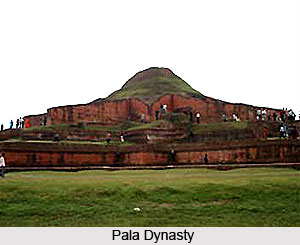 The Pala Empire was a Buddhist dynasty that ruled from Bengal in the eastern region. Pala rule was considered as the golden empire of Bengal. Ramapala was the successor of the Pala king Shurapala II. He extended his empire farther to Kamarupa, Orissa and Northern India after crush of the Varendra rebellion. The Ramacharitam attests Ramapala, as a Kshatriya. He was succeeded by Kumarapala. As per a myth he died by walking into the sea. Ramapala ruled for almost fifty three years.
The Pala Empire was a Buddhist dynasty that ruled from Bengal in the eastern region. Pala rule was considered as the golden empire of Bengal. Ramapala was the successor of the Pala king Shurapala II. He extended his empire farther to Kamarupa, Orissa and Northern India after crush of the Varendra rebellion. The Ramacharitam attests Ramapala, as a Kshatriya. He was succeeded by Kumarapala. As per a myth he died by walking into the sea. Ramapala ruled for almost fifty three years.
During revolt against Mahipala II, both of his brothers Surapala and Ramapala escaped to Magadha. Ramapala`s reign can be divided into two phases. One was his struggle against Kaivarta Kings and the other was revival of glory of Pala Dynasty. Ramapala had gathered support from feudatory chiefs and some Rashtrakuta kings and chiefs of various territories to overpower Bhima, third Kaivarta ruler of Virendra. All the chiefs readily agreed to help the Pala king and sent their forces to fight with the Kaivartas. Ramapala, along with the main body of his army, crossed over to the northern bank of the Ganga in Varendra. A severe battle followed between the armies of the two and thereby leading to Bhima`s defeat. Bhima and his family members were brutally executed by Ramapala thus recovering the ancestral kingdom.
After the re-conquest of Varendra, Ramapala undertook the work of reconstruction of the houses which were destroyed by the enemies. This prompted him to found a new capital city, which was named Ramavati after him. Ramapala adopted a liberal policy of taxation as high taxes were imposed on them by the Kaivarta rulers, and normal cultivation of lands was resumed under his patronage.
Ramapala tried to restore the former glory of his family after consolidating his position at home. This was done by conquering the adjoining regions to give a scientific figure to his province. The Varman king, Hari Varman, surrendered to his supremacy. The feudatories of Radha came under his influence. Ramapala sent an allied chief, who seems to have been Timgyadeva, to conquer the countries in the east. He defeated Dharmapala and brought Kamarupa under his dominion. Ramapala did despatch an elephant force against the Gahadavalas of Kannauj but it was revolted by the Gahadavala prince Govindachandra.
Two local kings of Orissa were quarrelling for power during Ramapala`s reign. One of them was backed by Ananta Varman Chodaganga of the Ganga dynasty, and the other was Somavamsi kesari king. Ramapala took up the cause of the latter and placed him on the throne after defeating Ananta Varman.
Ramapala` success was transitory. He could not maintain his influence there for long. Later on Ananta Varman succeeded in re-instating either Karnakesari or his successor on the throne of Utkala. Ramapala gave protection to a king of the Naka dynasty, who was harassed by the Nagas. He is said to have even captured the Naga capital. Ramapala did make an alliance with Chola king Kullotungo in order to be able to fight against Gangas and Chalukyas. It did not help him much as Chalukyas had invaded parts of Bengal and constantly created trouble for Ramapala.
King Govindachandra threatened the Pala Empire from Uttar Pradesh. However Ramapala kept a check on him by force and matrimonial alliance. On hearing the news of the death of his maternal uncle Mathanadeva, who was very dear to him, Ramapala committed suicide by drowning himself into the Ganga River near Munger. Ramapala was succeeded by Kumarapala, Gopala III and Madanapala.
This was the tragic end of an eventful and remarkable career. His strength of mind, resourcefulness and wonderful personality is a reason for admiration. He struggled hard to recover his ancestral land. His long life was full of military campaigns, crowned with success. His rule brought an era of peace and prosperity to Bengal. Death of Ramapala led to ultimate decline of the Pala dynasty.



















